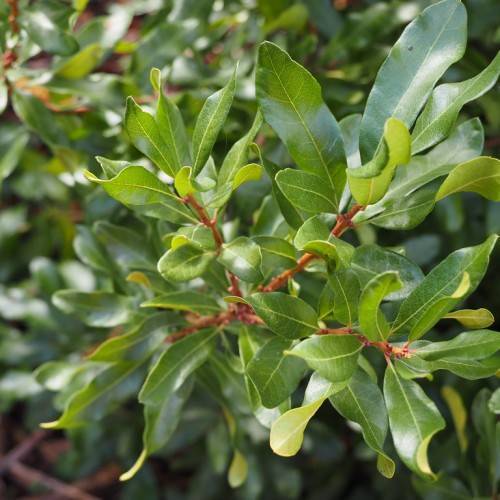
bayberry
Myrica pensylvanica
Cycle:
Perennial
Watering:
Frequent
Hardiness Zone:
3 - 7
Flowers:
Flowers In Spring
Sun:
Full sun,part shade
Soil:
Sandy Loamy Clay Humus Rocky
Fruits:
Fruits Ready In Fall
Leaf:
Yes
Growth Rate:
Low
Maintenance:
Low
Drought Tolerant:
Yes
Salt Tolerant:
Yes
Thorny:
Yes
Care Level:
Medium
watering
Bayberry (Myrica pensylvanica) is a native plant and should be watered at least 2-3 times a week. The best time to water it is in the morning so that the water is readily available to the plant and doesn't just run off the plant. During the hottest part of the day, water the bayberry deeply, ensuring that the water reaches the deep roots. For most soils, about 1 to 2 inches of water is adequate. For sandy soils, it's best to water a bit more, 3 to 4 inches, to make sure the water reaches all of its roots. In the colder months keep an eye on the soil's moisture levels to see if more frequent watering is needed.
sunlight
Bayberry (Myrica pensylvanica) prefers full sun to partial shade but can tolerate full shade. Bayberry does best in areas with moderate sunlight and does not need prolonged exposure to intense sunlight. For optimal growth and health, bayberry should receive at least 4 to 6 hours of sunlight a day. In areas with less sunshine, bayberry may not thrive as the amount of light needed for photosynthesis is decreased. During the hottest months of the summer, bayberry may require some protection from the sun, especially during the midday hours to minimize scorching and sunburn. In addition, during days with extended periods of intense sun, bayberry may benefit from some afternoon shade to prevent leaf and branch burn.
pruning
Bayberry (Myrica pensylvanica) should be pruned in late winter or early spring, just before the plant begins to bud. Prune out dead or diseased branches and any weak or crossing branches to promote good air circulation and reduce the potential for disease. Also remove branches growing toward the center of the shrub to create an open, vase-shaped appearance. This will promote light and air penetration to the interior and encourage strong outward growth. Prune out branches that are growing beyond the desired shape and size. Use sharp bypass shears and prune with caution as bayberry tends to produce an abundance of very sharp thorns.
